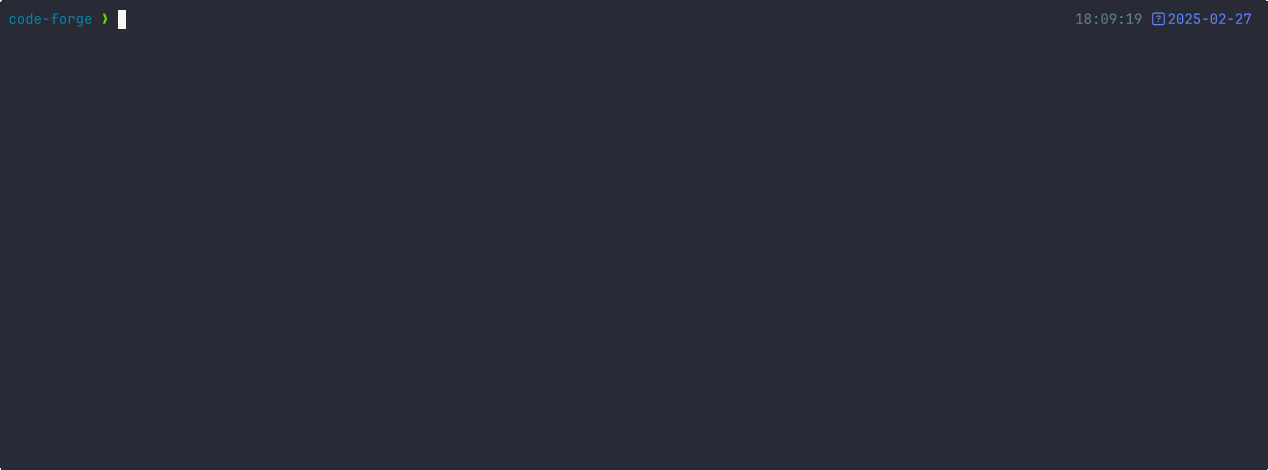A comprehensive coding agent that integrates AI capabilities with your development environment
npm install -g @antinomyhq/forge
Table of Contents
Install globally:
npm install -g @antinomyhq/forgeSign up at Antinomy.ai to enable the Forge provider.
Then set up your Forge provider key:
# .env
FORGE_KEY=ForgeKeyRun Forge in interactive mode:
forgeThat's it! Forge is now ready to assist you with your development tasks.
Forge can be used in different ways depending on your needs. Here are some common usage patterns:
Code Understanding
> Can you explain how the authentication system works in this codebase?
Forge will analyze your project's structure, identify authentication-related files, and provide a detailed explanation of the authentication flow, including the relationships between different components.
Implementing New Features
> I need to add a dark mode toggle to our React application. How should I approach this?
Forge will suggest the best approach based on your current codebase, explain the steps needed, and even scaffold the necessary components and styles for you.
Debugging Assistance
> I'm getting this error: "TypeError: Cannot read property 'map' of undefined". What might be causing it?
Forge will analyze the error, suggest potential causes based on your code, and propose different solutions to fix the issue.
Code Reviews
> Please review the code in src/components/UserProfile.js and suggest improvements
Forge will analyze the code, identify potential issues, and suggest improvements for readability, performance, security, and maintainability.
Learning New Technologies
> I want to integrate GraphQL into this Express application. Can you explain how to get started?
Forge will provide a tailored tutorial on integrating GraphQL with Express, using your specific project structure as context.
Database Schema Design
> I need to design a database schema for a blog with users, posts, comments, and categories
Forge will suggest an appropriate schema design, including tables/collections, relationships, indexes, and constraints based on your project's existing database technology.
Refactoring Legacy Code
> Help me refactor this class-based component to use React Hooks
Forge can help modernize your codebase by walking you through refactoring steps and implementing them with your approval.
Git Operations
> I need to merge branch 'feature/user-profile' into main but there are conflicts
Forge can guide you through resolving git conflicts, explaining the differences and suggesting the best way to reconcile them.
Forge is designed for developers who want to enhance their workflow with AI assistance while maintaining full control over their development environment.
- Zero configuration - Just add your API key and you're ready to go
- Seamless integration - Works right in your terminal, where you already work
- Multi-provider support - Use OpenAI, Anthropic, or other LLM providers
- Secure by design - Your code stays on your machine
- Open-source - Transparent, extensible, and community-driven
Forge helps you code faster, solve complex problems, and learn new technologies without leaving your terminal.
Here's a quick reference of Forge's command-line options:
| Option | Description |
|---|---|
-p, --prompt <PROMPT> |
Direct prompt to process without entering interactive mode |
-c, --command <COMMAND> |
Path to a file containing initial commands to execute |
-w, --workflow <WORKFLOW> |
Path to a file containing the workflow to execute |
-e, --event <EVENT> |
Dispatch an event to the workflow |
--conversation <CONVERSATION> |
Path to a file containing the conversation to execute |
-r, --restricted |
Enable restricted shell mode for enhanced security |
--verbose |
Enable verbose output mode |
-h, --help |
Print help information |
-V, --version |
Print version |
Forge supports multiple AI providers. Below are setup instructions for each supported provider:
Antinomy.ai (Recommended)
# .env
FORGE_KEY=ForgeKeyTo use Antinomy's provider with Forge:
- Visit https://app.antinomy.ai/
- Login with your existing credentials or create a new account
- Once logged in, your account will automatically enable the Forge Provider
No changes in forge.yaml required
OpenRouter
# .env
OPENROUTER_API_KEY=<your_openrouter_api_key>No changes in forge.yaml required
OpenAI
# .env
OPENAI_API_KEY=<your_openai_api_key># forge.yaml
model: o3-mini-highAnthropic
# .env
ANTHROPIC_API_KEY=<your_anthropic_api_key># forge.yaml
model: claude-3.7-sonnetGoogle Vertex AI
# .env
PROJECT_ID=<your_project_id>
LOCATION=<your_location>
OPENAI_API_KEY=<vertex_ai_key>
OPENAI_URL=https://${LOCATION}-aiplatform.googleapis.com/v1beta1/projects/${PROJECT_ID}/locations/${LOCATION}/endpoints/openapi# forge.yaml
model: publishers/anthropic/models/claude-3-7-sonnetOpenAI-Compatible Providers
# .env
OPENAI_API_KEY=<your_provider_api_key>
OPENAI_URL=<your_provider_url># forge.yaml
model: <provider-specific-model>Groq
# .env
OPENAI_API_KEY=<your_groq_api_key>
OPENAI_URL=https://api.groq.com/openai/v1# forge.yaml
model: deepseek-r1-distill-llama-70bAmazon Bedrock
To use Amazon Bedrock models with Forge, you'll need to first set up the Bedrock Access Gateway:
-
Set up Bedrock Access Gateway:
- Follow the deployment steps in the Bedrock Access Gateway repo
- Create your own API key in Secrets Manager
- Deploy the CloudFormation stack
- Note your API Base URL from the CloudFormation outputs
-
Create these files in your project directory:
# .env OPENAI_API_KEY=<your_bedrock_gateway_api_key> OPENAI_URL=<your_bedrock_gateway_base_url>
# forge.yaml model: anthropic.claude-3-opus
The forge.yaml file supports several advanced configuration options that let you customize Forge's behavior.
Custom Rules
Add your own guidelines that all agents should follow when generating responses.
# forge.yaml
custom_rules: |
1. Always add comprehensive error handling to any code you write.
2. Include unit tests for all new functions.
3. Follow our team's naming convention: camelCase for variables, PascalCase for classes.Commands
Define custom commands as shortcuts for repetitive prompts:
# forge.yaml
commands:
- name: "refactor"
description: "Refactor selected code"
prompt: "Please refactor this code to improve readability and performance"Model
Specify the default AI model to use for all agents in the workflow.
# forge.yaml
model: "claude-3.7-sonnet"Max Walker Depth
Control how deeply Forge traverses your project directory structure when gathering context.
# forge.yaml
max_walker_depth: 3 # Limit directory traversal to 3 levels deepTemperature
Adjust the creativity and randomness in AI responses. Lower values (0.0-0.3) produce more focused, deterministic outputs, while higher values (0.7-2.0) generate more diverse and creative results.
# forge.yaml
temperature: 0.7 # Balanced creativity and focusFor comprehensive documentation on all features and capabilities, please visit the documentation site.
Join our vibrant Discord community to connect with other Forge users and contributors, get help with your projects, share ideas, and provide feedback!
Your support drives Forge's continued evolution! By starring our GitHub repository, you:
- Help others discover this powerful tool 🔍
- Motivate our development team 💪
- Enable us to prioritize new features 🛠️
- Strengthen our open-source community 🌱



